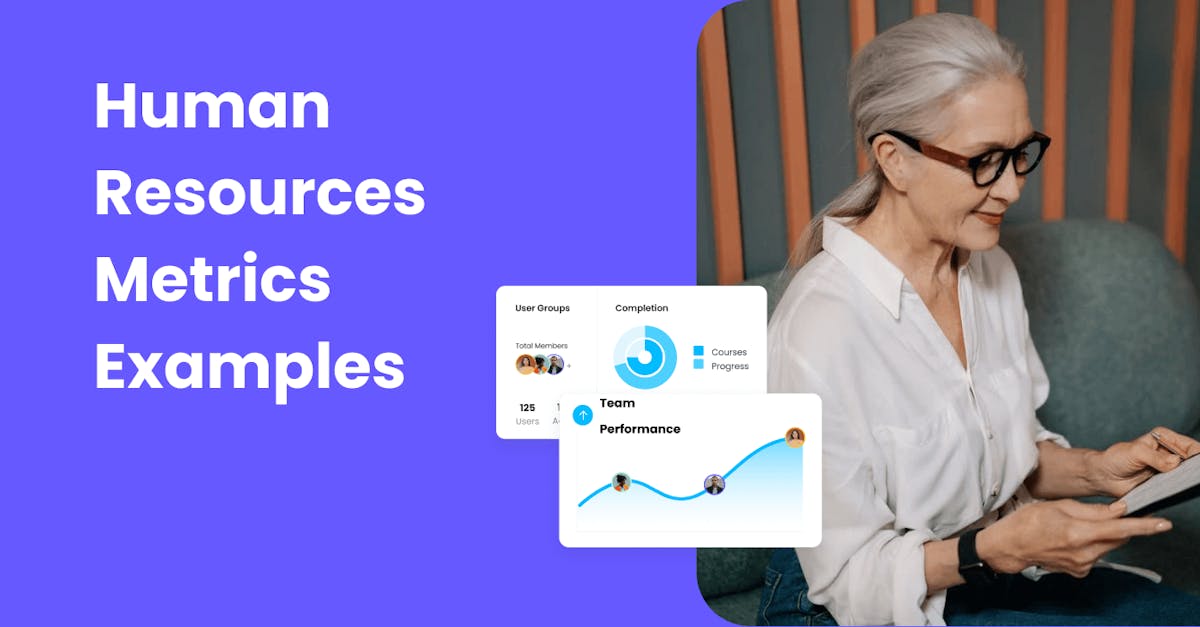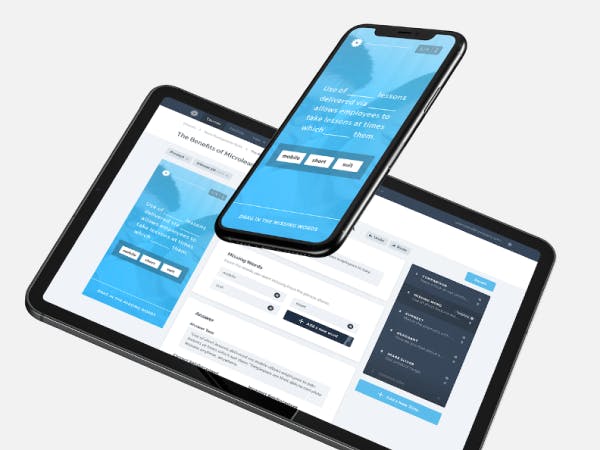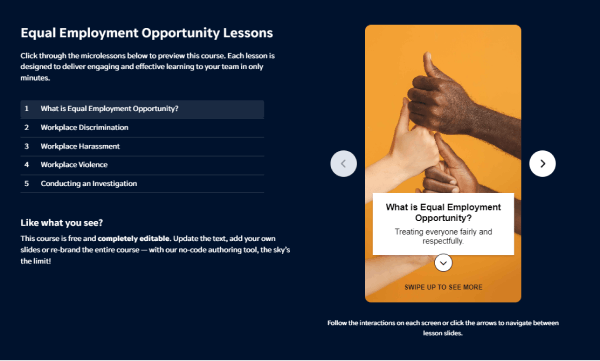10 Human Resources Metrics Examples

Human resources metrics can be used to monitor and improve employee productivity and assess the success of HR efforts. That being said, it’s not surprising why most businesses today are treating them with utmost priority. But what are some examples of human resources? In this post, we’ll go through the most common human resources metrics examples used in the field and help you see them in a more familiar context.
1. Employee engagement rating
Employee engagement is an indicator of a satisfied and productive workforce, which is why it’s regarded as one of the most vital human resources metrics examples. After all, employees who are highly engaged at work are more enthusiastic to be involved in the goals of their organizations and are more motivated to do their best. This, in turn, leads to long-term success and a healthier business bottom line.

To assess your team’s engagement rating, you can create business-wide survey questions and ask them about their experiences working for the company. One of the best ways to do this is by using a rating scale. Tell your team to rank their level of engagement at work on a scale of one to five, with five representing the highest rating and one the lowest.
You can also send an open-ended survey question to get a more elaborate response from your team. Ask them what they enjoy the most or least about their work environment, what inspires them to do their job well, the barriers hindering them from performing well, and so much more. These survey questions will help you see things from your team’s perspectives as you hear answers in their own words.
Creating surveys and getting raw insights from your team isn’t exactly a walk in the park. But, it can be simplified with the help of EdApp. This tool houses a range of great survey templates that require no complex authoring process. Some survey templates that you can use include a text survey, a multiple-choice survey, a slider that looks like a rating scale, and a quadrant.

But that’s not all – the survey results will be collected in the analytics suite, which is also a great feature of EdApp. There’s a “view responses” page that will give you a summary of your survey responses. If more examination of the raw data is needed, these results can be exported to CSV.
Start measuring your employee engagement rating today with EdApp! Sign up for free to get started.
2. Training cost per employee
Employees’ performance and productivity at work can be increased by providing them with continuous and relevant training. But here’s the thing – most training programs come with a cost. In many instances, you’ll have to pay for the equipment and materials, the venue and food, and sometimes, even the transportation fees. Online training sessions are typically cheaper, but still, you’ll have to think about the internet cost or even the overtime pay for those who are doing extra work to build your learning materials.

All things considered, it’s important to measure how much it costs to train each of your employees. The calculation is simple – just compute your training costs and then divide it by the overall number of participating trainers. By using this human resources metrics example, you can rest at ease knowing that your team receives adequate training to advance their knowledge and abilities. And the best part is you can help them upskill while staying within your allocated spending limits.
Maybe you’re thinking about organizing employee training? EdApp is equipped with a range of interactive training solutions that can help give your team a better learning experience without breaking the bank. This online training software is built with a template-based course creator tool that you can use to create human resource courses and data entry training courses for free. It also offers a hassle-free PowerPoint conversion tool, gamification elements like leaderboards and a reward system, and more.

Learn more by visiting them at www.edapp.com.
3. Employee turnover
What are HR metrics that are commonly measured for business success? Well, another vital human resources metrics example that you should track in your HRIS software is the employee turnover rate. Frequently losing employees can mean a lot of things – they’re feeling too overwhelmed with the volume of their work, there’s a lack of recognition, poor relations with the team and their leaders, and more. If left unaddressed for long, these concerns can severely impact your brand reputation and scare away great talents from joining your team.

By monitoring your employee turnover rate, you can identify any issues affecting your team before they spiral out of control. You can calculate it by dividing the number of resignations by the average total number of your employees (and then multiply by 100 to get a percentage). Use this data to find patterns as to why you’re losing your people. From there, reshape your people strategy to break those patterns and minimize the number of people leaving your organization.
4. Retention rate
Similar to the employee turnover rate, it’s also vital to pay close attention to your employee retention rate as part of your hr matrix. The focus of this human resources metrics example is to get a granular view of whether or not you have a healthy workplace culture that prevents people from jumping to another company. It can help you figure out which strategies are effective, particularly in terms of retaining your employees’ satisfaction and motivation, so you can keep implementing them.

A report of your retention rate can also be used to elevate the interest of investors in a company. Show them that you have a knack for retaining great talents to increase their trust and secure their investment. A good retention rate is also a good way to get the attention of the most talented people out there and encourage them into joining your team.
This HR metric is usually evaluated at the end of the year (or fiscal year for some). To calculate it, you just need to subtract the total number of separations from the average number of your employees, and then divide it by the total number of your employees. To convert it to a percentage, multiply it by 100.
5. Performance and potential
Performance and potential are metrics commonly used to find the top performers of your team and those with the highest potential to fill critical leadership and managerial positions in the future. This human resources metrics example can help you improve your organizational structure and align people based on their competency level. Some companies also use it to identify underperformers and give them the support they need to improve their performance. Additionally, courses like leadership, communication skills, and gender inclusivity training courses can help to ensure that all employees are productive and feel like they are improving their performance.

A nine-box matrix is a well-known tool for assessing this metric. It gives you a better visualization of how your employees are currently performing and how they’re projected to perform in the future (in other words, their growth potential).
Check out this wonderful guide from The Balance Careers, Develop Leaders Using the 9-Box Performance Matrix, to see how this assessment tool can be used to track the performance and potential levels of your employees.
6. Revenue Per Employee
Revenue per employee gives a rough estimate of how much money is generated per individual at a company. It can be evaluated by dividing the total amount of revenue generated in a cycle by the number of your employees. Although it appears to be pretty basic, this metric is crucial for assessing the productivity of an employee and how their talent is contributing to your topline. A higher percentage indicates higher productivity, which frequently translates to higher company profits.

7. Goal tracking
Most organizations set goals to give their team guidance and a unified direction. After all, it’s tempting to just slack off without a specific purpose in mind. But how can you tell if your team is on the right course in the process of reaching these goals? This is where the importance of goal tracking comes in.
For this HR metric, it’s important to check vital things such as the percentage of the goals that have been met so far, and the time used vs the time predicted for them to accomplish these goals. The result will help you identify certain processes that have helped your team move closer to their goals, as well as those that have significantly slowed them down. This is the perfect opportunity to pinpoint whatever is affecting their goal progress and address them right away.
8. Time to hire
Longer hiring times not only increase hiring costs but can also cause you to lose your best candidates. This is why the time-to-hire metric is very important.

In its simplest form, time to hire refers to the overall time it took for you to sign a new employee, starting from the job posting to accepting the job offer. For this metric, it’s best to keep a spreadsheet and record the days you spend hiring each candidate. Sum up all those days and then divide that by the total number of hires you were able to sign – that’s your time-to-hire average. This number will help you determine if your hiring process is efficient, and adjust it accordingly if it’s not.
9. Offer acceptance rate
The offer acceptance rate (OAR) describes the ratio of offers accepted by candidates to the total number of offers sent by the company. This metric can also help you determine the success of your recruiting efforts, but unlike the time-to-hire ratio, this gives you a deeper insight into whether your company’s competent enough to sign a pool of great talents.

A low OAR typically indicates a low salary or poor compensation offer, although sometimes, it can also signify a bad interview experience or a problem with the company’s reputation. To find out the reason behind the number, you could ask these candidates directly why they turned down the offer. Compare their answers, and from there, adjust your hiring strategy based on the key reasons why you’ve been getting a low acceptance rate.
Similarly, you can also send a survey to those who accepted your job offer to identify which steps in the hiring procedure should be kept.
10. Demographics/ Diversity metric
The demographics/ diversity metric looks at the characteristics of your workforce. This metric comes particularly handy if you need to submit an EEO-1 (Equal Employment Opportunity Commission) report, a demographic breakdown report of a company’s workforce by race and gender. This compliance report is usually required from companies with more than a hundred employees.

In most cases, the result of this metric gives you a clearer picture of whether or not your company offers an equal opportunity for all, regardless of age, gender, education level, and professional experience. It’s also a good chance to spot and fix any inequalities and inequities in your organization.
Looking to know more about the concept of Equal Employment Opportunity (EEO)? EdApp has put together a helpful course on Equal Employment Opportunity, which drills down the policies and importance of EEO. It also discusses in detail how discrimination, harassment, and violence manifest in the workplace.

The content of this course follows a micro learning model, meaning, they have been broken down into short bursts to make learning more effective and engaging. And the best part? This course is free to take and share with your team!
Author
Jeanellie Avelino
Jen is a learning expert at EdApp, a mobile-based training platform that helps corporates and businesses bring their training solutions to the next level. She carries an extensive writing experience in a variety of fields, including architecture, the gig economy, and computer software. Outside of work, she enjoys her free time watching her favorite series and documentaries, reading motivational books, and cross-stitching.
